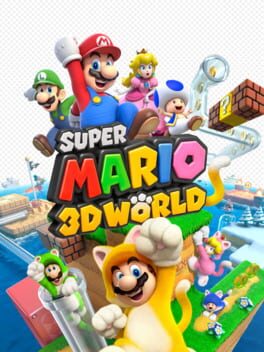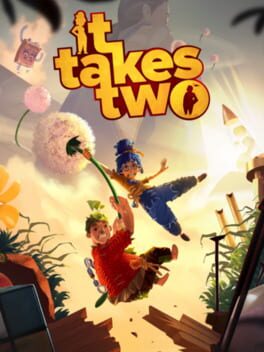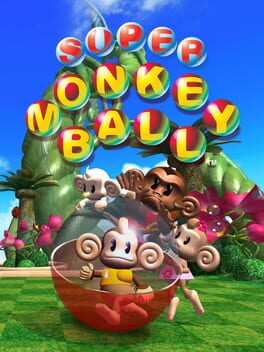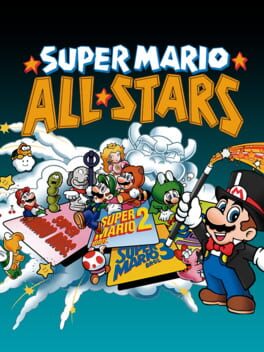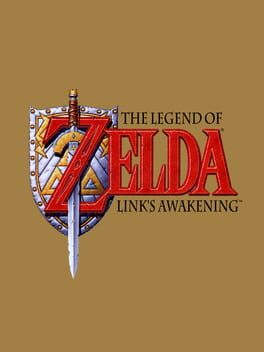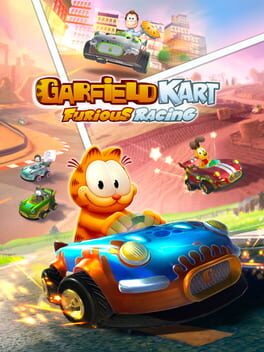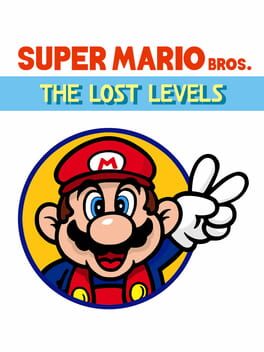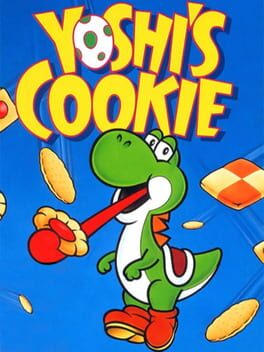It indeed has decently comedic writing, good style, interesting setting and characters and kickstarted an influential RPG franchise. While I do consider this to have been a pleasing experience in the greater scheme of things, there are many things which have infuriated me, such as unbalanced boss fights (including the completely unbalanced Mush Badge which allowed me to 2-hit KO one of the most infamous final bosses in the franchise), cryptic mechanics (i.e. Advance attacks) and a lot of very repetitive enemy spamming. It is worth playing for the exploration aspect and to experience the writing, but it is one of those RPGs where I feel like they might have been better off just making a comic.
2021
3D World is a childhood favourite of mine, and I dipped my toes in speedrunning it when I was a teenager. However, I haven't played it in about half a decade due to having a bricked Wii U -- therefore, it feels good to finally get to play this port. This is a very solid and underappreciated 3D Mario game with excellent level design, good progression in difficulty, and a rather epic post-game (maybe the best in the entire Mario series?) which ends in the absolute hardest Mario in an official game.
This release is essentially the same game as on the Wii U, but I have some specific notes about this port:
- While the controls have been decently well ported, but it is still a game which was intrinsically built for the Wii U's gamepad, and in that regard, there is not a single controller that works as well for it. To complement the screen, they used the same pointer system that was used in the 3D All-Stars port of Super Mario Galaxy to emulate the original DS-style screen touching. It works fine, but it feels clunky and unnatural compared to how satisfying it felt to interact with the world in the original version.
- The mid-air roll--just about the only thing that was added in this port compared to Wii U--is a new move I have positive feelings for. It allows for some pretty cool trick-jumping and SMW-esque cheese. It got me out of some crazy situations and had me experimenting with the limits of movement.
- Another thing they added is Photo mode, which they seem to have almost directly ported from Super Mario Odyssey but I really could care less for it. This game does not have the same type of theatrical settings as Odyssey so the opportunity for memorable screenshots is very limited.
- Unfortunately, the only use for Stamps appears to be for use in the aforementionned Photo mode. It was more rewarding to get the stamps on Wii U in order to use them on Miiverse, but now there is really no reason to get them other than to unlock the final world.
- Finally, it goes without saying that 380 Stars/80 Stamps should more than ever be considered the de facto 100% completion of this game. The genuine 100% completion--which involves beating every level in the game at least five times--is an absolute load of horse crap. At least, on Wii U, you got rare stamps to use on Miiverse, but now that Miiverse isn't a thing, it is a pointless and excruciating endeavour (unless you're willing to spend numerous hours replaying the game 4 more times to get an extra star on your file).
I am satisfied with this port, and if you find a good deal for it 2nd hand, it might be worth playing if you are an OG 3DW player. I was lucky enough that I was lent this game, but I would still have not complained if I paid it full-price because it is a very fine rerelease considering the tools they had. I am also excited to finally play through Bowser's Fury!
This release is essentially the same game as on the Wii U, but I have some specific notes about this port:
- While the controls have been decently well ported, but it is still a game which was intrinsically built for the Wii U's gamepad, and in that regard, there is not a single controller that works as well for it. To complement the screen, they used the same pointer system that was used in the 3D All-Stars port of Super Mario Galaxy to emulate the original DS-style screen touching. It works fine, but it feels clunky and unnatural compared to how satisfying it felt to interact with the world in the original version.
- The mid-air roll--just about the only thing that was added in this port compared to Wii U--is a new move I have positive feelings for. It allows for some pretty cool trick-jumping and SMW-esque cheese. It got me out of some crazy situations and had me experimenting with the limits of movement.
- Another thing they added is Photo mode, which they seem to have almost directly ported from Super Mario Odyssey but I really could care less for it. This game does not have the same type of theatrical settings as Odyssey so the opportunity for memorable screenshots is very limited.
- Unfortunately, the only use for Stamps appears to be for use in the aforementionned Photo mode. It was more rewarding to get the stamps on Wii U in order to use them on Miiverse, but now there is really no reason to get them other than to unlock the final world.
- Finally, it goes without saying that 380 Stars/80 Stamps should more than ever be considered the de facto 100% completion of this game. The genuine 100% completion--which involves beating every level in the game at least five times--is an absolute load of horse crap. At least, on Wii U, you got rare stamps to use on Miiverse, but now that Miiverse isn't a thing, it is a pointless and excruciating endeavour (unless you're willing to spend numerous hours replaying the game 4 more times to get an extra star on your file).
I am satisfied with this port, and if you find a good deal for it 2nd hand, it might be worth playing if you are an OG 3DW player. I was lucky enough that I was lent this game, but I would still have not complained if I paid it full-price because it is a very fine rerelease considering the tools they had. I am also excited to finally play through Bowser's Fury!
2021
Doesn't do anything new; It Takes Two ports pre-existing ideas from some of the best video games games in history to a cooperative context and massively succeeds in doing so. It indeed clearly takes significant inspiration from Nintendo games, especially Super Mario Odyssey's transformations and its aesthetics is sometimes comparable to 3D Zelda dungeons, sometimes to Pikmin, sometimes it plays like Mario Kart, sometimes it plays a bit like Metroid... it's extremely diverse in its playstyles and inspirations, yet surprisingly, it succeeds in everything it attempts to do. The beauty of its environments is jaw-dropping (especially for an Unreal Engine game), the gameplay (incl. 3D platforming movement, which isn't an easy thing to master) is smooth, and everything it tries works so well with co-op. My girlfriend and I felt engaged from the beginning to the end, and I especially fell under the game's charm in the latter half.
Its ultra-linear progression sometimes make the levels feel rather hollow, giving not much reason to explore new environments. Furthermore, its fast pacing and perpetually changing gameplay makes it feel a tad unfocused and elusive at times. Writing is also extremely cringe-worthy at times--although Dr. Hakim's incredible personality completely fixes that. I would have hoped for each section to be a little more fleshed out and to have more collect-o-thon elements in it.
Despite that, It Takes Two is an essential short game to play with somebody--whether it's your significant other, a good friend, an avid gamer, a non-gamer--it has something for everybody and I was pleasantly suprised by its quality. Never knew EA were capable of publishing an actually fun and innovating game.
Its ultra-linear progression sometimes make the levels feel rather hollow, giving not much reason to explore new environments. Furthermore, its fast pacing and perpetually changing gameplay makes it feel a tad unfocused and elusive at times. Writing is also extremely cringe-worthy at times--although Dr. Hakim's incredible personality completely fixes that. I would have hoped for each section to be a little more fleshed out and to have more collect-o-thon elements in it.
Despite that, It Takes Two is an essential short game to play with somebody--whether it's your significant other, a good friend, an avid gamer, a non-gamer--it has something for everybody and I was pleasantly suprised by its quality. Never knew EA were capable of publishing an actually fun and innovating game.
2001
2007
Casually, the greatest 3D Mario game.
The "gravity/planets" gimmick is done exceptionally well and surprisingly has very little problems with camera glitches, and doesn't get old. Level design feels perpetually unique and grand. Controls are exceptionally responsive, especially when playing on Wiimote and Nunchuck. The motion-controlled spin attack is very responsive and complex. By holding A or not, and spinning with one or the other controller, different heights can be reached, with various different response times. The skill ceiling for this game is very high, making it one of the most interesting emerging speedrunning scenes.
Being the first linear game of the series, for the average player, the goals of each mission is clear and simple. This allows the game to focus on gorgeous cutscenes, cinematics, camera angles, and allows the player to explore individual planets rather than a large open space (with the exception of some levels, namely Beach Bowl and Honeyhive).
The 64/Sunshine-esque "open world" aspect is not totally lost, though. The Purple Comet missions allow for a revisit of each level which feels not too distant from 64's 100-coins missions and Sunshine's blue coins, while having less of a chance of getting lost or being unable to find coins.
Despite being a linear game, Galaxy promotes exploration by allowing players to go for highest coin counts for each mission, by hiding secret stars in levels, as well as having tons of hidden places to find starbits. Unlike other linear 3D Mario games, such as 3D World or 3D Land, Galaxy lets the player explore the level without getting lost, yielding a perpetual engaging experience unlike anything else in the series.
The atmosphere of Super Mario Galaxy has been talked about to death, with good reason. The Mario Galaxy Orchestra's performances of Yokota and Kondo's music never fail to make each level so much more engaging. The cutscenes and camera angles feel meticulously handpicked by cinematic experts.
Exceptionally for a Mario game, the surprisingly complex storyline and Rosalina's character answer metaphysical questions about the series, and ask questions about love, family and death.
Possibly Nintendo's greatest and most complete Mario accomplishment. No filler, just complete engagement from the player throughout the entirety of the one hundred and twenty missions. A staple for 3D platformers and one of the most important games of the last generation.
The "gravity/planets" gimmick is done exceptionally well and surprisingly has very little problems with camera glitches, and doesn't get old. Level design feels perpetually unique and grand. Controls are exceptionally responsive, especially when playing on Wiimote and Nunchuck. The motion-controlled spin attack is very responsive and complex. By holding A or not, and spinning with one or the other controller, different heights can be reached, with various different response times. The skill ceiling for this game is very high, making it one of the most interesting emerging speedrunning scenes.
Being the first linear game of the series, for the average player, the goals of each mission is clear and simple. This allows the game to focus on gorgeous cutscenes, cinematics, camera angles, and allows the player to explore individual planets rather than a large open space (with the exception of some levels, namely Beach Bowl and Honeyhive).
The 64/Sunshine-esque "open world" aspect is not totally lost, though. The Purple Comet missions allow for a revisit of each level which feels not too distant from 64's 100-coins missions and Sunshine's blue coins, while having less of a chance of getting lost or being unable to find coins.
Despite being a linear game, Galaxy promotes exploration by allowing players to go for highest coin counts for each mission, by hiding secret stars in levels, as well as having tons of hidden places to find starbits. Unlike other linear 3D Mario games, such as 3D World or 3D Land, Galaxy lets the player explore the level without getting lost, yielding a perpetual engaging experience unlike anything else in the series.
The atmosphere of Super Mario Galaxy has been talked about to death, with good reason. The Mario Galaxy Orchestra's performances of Yokota and Kondo's music never fail to make each level so much more engaging. The cutscenes and camera angles feel meticulously handpicked by cinematic experts.
Exceptionally for a Mario game, the surprisingly complex storyline and Rosalina's character answer metaphysical questions about the series, and ask questions about love, family and death.
Possibly Nintendo's greatest and most complete Mario accomplishment. No filler, just complete engagement from the player throughout the entirety of the one hundred and twenty missions. A staple for 3D platformers and one of the most important games of the last generation.
Obviously one of the SNES's most essential releases. Solid revisit of the original Mario tetralogy, with remastered sounds and visuals. A lot of the things that were annoying about the original games (i.e. no battery save, having to beat SMB2J 8 times to unlock worlds A-D) are corrected. However, gameplay wise, the games are very faithful to their original NES and FDS versions. Indeed the definitive way to play these games.
2008
The absolute finest and wildest multiplayer game I've ever played. Comes with 16 new unforgettable tracks, 16 beautiful remasters of old Mario Kart tracks, accompanied by one of the greatest Nintendo soundtracks. The mechanics of this game are the most complex of any Mario Kart game, giving this game virtually no skill ceiling. Online multiplayer, despite the official one being shut down, is getting more and more fun and active through Wiimmfi. The modding scene and custom tracks for this game are unlike anything I've ever seen. One of the most difficult but rewarding games to master. Playing this game online brings me some of the most addicting, frustrating and satisfying feelings ever. A true test of your quick decision making. A true adrenaline pump. Masterpiece.
1986
It has to be appreciated for its historic value; this is not only the very first cartridge in video gaming history to include a battery save--a feature we take for granted nowadays--but it's also a phenomenal adventure game with a complex storyline and a captivating atmosphere, at least for 1986 standards. Let's just say we're light years ahead of Adventure on the Atari 2600 in that regard. Miyamoto indeed successfully managed to emulate the grandiose childlike feeling of natural exploration and it feels like you've never truly found everything that the map has to offer.
The screens perpetually get filled with challenging enemies that have some of the most complex battle styles and advanced AI I've seen in that era of video gaming. It requires a lot of strategy to just clear some of these screens. The frequent "fight or flight response" feelings that this game brings upon the player makes me see it as the first great shift away from traditional mindless fighting styles (shooter/jump on top of the enemy), and therefore, in a way, this game is the grandfather of all RPGs in the way that it brought upon complex enemies, numerous different items and weapons, as well as experimental battle styles.
However, despite how much we owe to this game, it goes without saying that it has aged considerably. Firstly, it's an excessively cryptic game. The Legend of Zelda is practically impossible to complete without some sort of strategy guide. The map that comes printed in the manual is practically useless in terms of progressing through the game. An authentic playthrough would at least require hours of scavenging every single screen in the map, of walking back and forth between screens with the horrendous candle that can only be used once per screen transition (who thought this was a good idea?) and wasting bombs, which are a very scarce commodity, trying to blow up unmarked walls. A game that requires further reading in a book or on the web to complete will inherently leave a sour feeling in my mouth. Titles like Castlevania II and Milon's Secret Castle are often harshly criticized for the very same type of cryptic secrets that are required to make progress through the story. Yet, Zelda, in all its praise, is guilty of the same crimes.
Furthermore, I was disappointed in how some of those dungeons are designed. Having to perpetually and arbitrarily light up some the rooms is tedious and redundant. Enemies like Darknuts and Wizzrobes are some of the most annoying I've ever had to deal with. If Like Likes touch you, they destroy your Magic Shield, which is one of the most expensive items in the game. This annoyed me to no end. Some of the rooms are so saturated with random enemies that there are framerate issues with the original NES. Bosses are reused between dungeons. A bit more thought could have been put in how these dungeons are designed.
So, is NES Zelda still worth playing? Most definitely if you have interest in retro gaming or video gaming history, but otherwise, you can probably skip that one. I got a fair bit of enjoyment out of it but it's most definitely an aging game. I might come back for the second quest at some point if I'm brave enough.
The screens perpetually get filled with challenging enemies that have some of the most complex battle styles and advanced AI I've seen in that era of video gaming. It requires a lot of strategy to just clear some of these screens. The frequent "fight or flight response" feelings that this game brings upon the player makes me see it as the first great shift away from traditional mindless fighting styles (shooter/jump on top of the enemy), and therefore, in a way, this game is the grandfather of all RPGs in the way that it brought upon complex enemies, numerous different items and weapons, as well as experimental battle styles.
However, despite how much we owe to this game, it goes without saying that it has aged considerably. Firstly, it's an excessively cryptic game. The Legend of Zelda is practically impossible to complete without some sort of strategy guide. The map that comes printed in the manual is practically useless in terms of progressing through the game. An authentic playthrough would at least require hours of scavenging every single screen in the map, of walking back and forth between screens with the horrendous candle that can only be used once per screen transition (who thought this was a good idea?) and wasting bombs, which are a very scarce commodity, trying to blow up unmarked walls. A game that requires further reading in a book or on the web to complete will inherently leave a sour feeling in my mouth. Titles like Castlevania II and Milon's Secret Castle are often harshly criticized for the very same type of cryptic secrets that are required to make progress through the story. Yet, Zelda, in all its praise, is guilty of the same crimes.
Furthermore, I was disappointed in how some of those dungeons are designed. Having to perpetually and arbitrarily light up some the rooms is tedious and redundant. Enemies like Darknuts and Wizzrobes are some of the most annoying I've ever had to deal with. If Like Likes touch you, they destroy your Magic Shield, which is one of the most expensive items in the game. This annoyed me to no end. Some of the rooms are so saturated with random enemies that there are framerate issues with the original NES. Bosses are reused between dungeons. A bit more thought could have been put in how these dungeons are designed.
So, is NES Zelda still worth playing? Most definitely if you have interest in retro gaming or video gaming history, but otherwise, you can probably skip that one. I got a fair bit of enjoyment out of it but it's most definitely an aging game. I might come back for the second quest at some point if I'm brave enough.
Extremely ambitious in terms of size, storytelling and aesthetics. It is indeed a significant achievement in software development and game design that something like that even existed on the Game Boy so early in its lifespan. The black and white graphics are absolutely gorgeous--they fit the "dream" aesthetic wonderfully and leave a lot to be imagined by the player. Dungeons get extremely complex and labyrinthine near the end of the game, and the final boss fight is one of the coolest and most difficult I've ever experienced in retro gaming. Really well encapsulates the quintessential "frustrating and confusing, but satisfying and engaging"
Some of its structure frustrated me a bit; the overworld is filled with random cul-de-sacs and can be extremely frustrating to navigate even w/ the map and warps. Imagine Dark World in ALTTP but twice as difficult to navigate. At times this made me disconnect from the game and brought me significant frustration as there is so much backtracking and getting lost. Some puzzles in the dungeons are pretty dumb too, i.e. there is some Zelda 1-esque "go bomb this random wall that has no cracks" bullshit in some dungeons, which is unforgiveable in my mind for a game released after ALTTP.
Yet, Link's Awakening is indeed a statement in story telling for Zelda, it's difficult, and it's one of the most beautiful Game Boy games I've seen. It's a great game in many regards, and I definitlely want to try playing the remaster in the future.
Some of its structure frustrated me a bit; the overworld is filled with random cul-de-sacs and can be extremely frustrating to navigate even w/ the map and warps. Imagine Dark World in ALTTP but twice as difficult to navigate. At times this made me disconnect from the game and brought me significant frustration as there is so much backtracking and getting lost. Some puzzles in the dungeons are pretty dumb too, i.e. there is some Zelda 1-esque "go bomb this random wall that has no cracks" bullshit in some dungeons, which is unforgiveable in my mind for a game released after ALTTP.
Yet, Link's Awakening is indeed a statement in story telling for Zelda, it's difficult, and it's one of the most beautiful Game Boy games I've seen. It's a great game in many regards, and I definitlely want to try playing the remaster in the future.
For a game that is so notoriously difficult, it's disappointing to see how much of its difficulty stems in pseudo-difficulty: pick-a-path, find this hidden block, guess what the right decision is before the screen scrolls too far... once you know the layout of these levels, it's really not too hard, and is just an awkward experimental version of SMB1.
I really liked World 9, so I'd love to play the four bonus worlds, but I seriously can't be bothered beating this thing eight times in a row. So it'll likely stay as is.
I'm glad we got Doki Doki Panic instead of this in the West.
I really liked World 9, so I'd love to play the four bonus worlds, but I seriously can't be bothered beating this thing eight times in a row. So it'll likely stay as is.
I'm glad we got Doki Doki Panic instead of this in the West.
1990
Likely the peak of 2D Mario excellence. Excellent and engaging level design, gorgeous and colorful sprites, lots of great content, especially in the post game, and an unforgettable soundtrack. Finding all 96 exits is an exciting and challenging endeavour. The switch to the new system adds saving and much more powerful cartridges, letting Nintendo masterfully execute all the ideas they had in mind while letting the player beat the game at their own pace. This game shows the potential of the SNES had as a gaming system, the amount of creativity the esceptional team had. Funny, gorgeous, grand and immensely fun. One of the great masterpieces of gaming and the ultimate bridge between the 80's and the 90's.
Choosing to follow the original Zelda's play style rather than making another Link's Adventure worked incredibly well here. Indeed, A Link to the Past builds on the concepts that were tried out with Zelda 1 and makes just about everything better. The controls are satisfying and there is a huge variety of items are your disposal to try and figure out what the next step is. It just tickles the brain in a certain way that is so satisying; you'll get to a screen where you will have no idea what to do, and you will progressively get more and more of an idea what to do to progress until you actually manage to logically figure it out by yourself. It also shows how desperately top-down Zelda needed a more proper map system than the NES's very primitive one. Everything just works perfectly, it's incredibly difficult, has you thinking a lot, and just feels amazing to progress in. However, some of the puzzles near the end of the game did push my patience in terms of how cryptic they were a bit further than what I was comfortable with; I did use the help of the internet a handful of times for the very rare occasions where this game tries to pull some NES Zelda-type cryptic secret that is required to progress through the game. Furthermore, some of the game design did lead to a fair bit of backtracking and mindless exploration of the overworld with no idea what to do next (even though the hints given by the psychic dude worked pretty well for the most part in figuring out what to do next). My complaints are few and scarce though, this is indeed an amazing SNES game and it makes me excited to play the following installments in the series.
1993
Clear lines of similarly-shaped pieces and they dissapear, while being quick enough to avoid new falling pieces. It really is everything you should expect from Bullet-Proof Software: it's a well-presented, easy to pick up and addicting Tetris-style puzzle game. Sprite work is very solid and the atmosphere kept me engaged until the very end. Regular game isn't too hard, containing 100 stages which were pretty easy but fun for me to play through.
Cartridge also contains split-screen multiplayer (which I have yet to try) and a Puzzle mode in which you have to clear a preexisting set of lines in a maximum amount of moves. There are 100 of these puzzles, and they were designed by Tetris creator Alexei Pazhitnov. Don't really feel like playing these for the time being, but if I ever want to get better at the main game (to speedrun or whatever), then those puzzles could help me get better at the game.
Regardless, it has a lot to do and has very fine replayability. Worth obtaining.
Cartridge also contains split-screen multiplayer (which I have yet to try) and a Puzzle mode in which you have to clear a preexisting set of lines in a maximum amount of moves. There are 100 of these puzzles, and they were designed by Tetris creator Alexei Pazhitnov. Don't really feel like playing these for the time being, but if I ever want to get better at the main game (to speedrun or whatever), then those puzzles could help me get better at the game.
Regardless, it has a lot to do and has very fine replayability. Worth obtaining.

